If my decomposing carcass helps nourish the roots of a juniper tree or the wings of a vulture — that is immortality enough for me. And as much as anyone deserves.
—Edward Abbey, A Voice Crying in the Wilderness
When you hear the word “desert,” what comes to mind?
Perhaps it’s her sweeping hills of dust and sand, or giant mountains only suitable for reptiles and spiders. Or maybe it’s her shining sun, the fields of prickly cacti, and the scorpions willing to sting your bare toes. You might even picture suburban neighborhoods with yards of nothing but rocks and maybe some lifeless bushes or plaza malls swollen with sidewalk strips.
Some of these might ring true, but they are not the whole picture. The truth is, the desert is so much more than blankets of withered sediments; she’s a multifaceted, breathing motherland that soothes and provides.
Imagine waking at dawn, opening your dewy windows, brewing your morning coffee while admiring your Texas ebony, and hearing peach-faced lovebirds chirping in the sunflowers. Picture walking out the back door to feed the dog an overripe orange from your own tree, then watering your bed of nightshades flourishing underneath a Florida Prince peach.
These blissful dreams of a vibrant home life are entirely possible but a daily reality for Arizonians like me. My childhood home where I live has become a palatable oasis in an unlikely place through tireless labor and generational practice. I’d like to introduce you to the concept of a food forest, which we have created here, and how we can enjoy such bounty in an inhospitable climate.
With minor investments in mulch and patience, you too can use permacultural principles to achieve a delicious food forest right in your backyard, wherever you are, in under a year. All you need is a private outdoor space and the willpower to get your hands dirty. If you don’t have your own yard to plant in, you can still apply some of these ideas to a community garden plot. Because most community gardens prohibit the planting of at least large perennials, you won’t be able to achieve a full food forest with its seven tiers of plants, or “layers.” Still, even by establishing just the lower layers, your soil will benefit from increased moisture retention, fertility, and biodiversity.
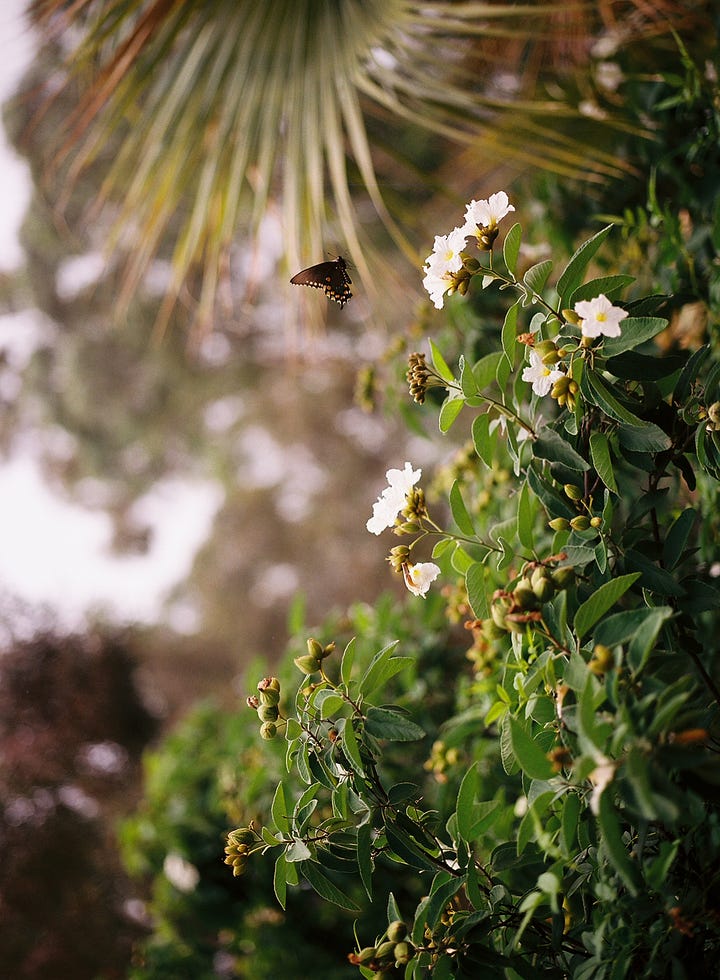
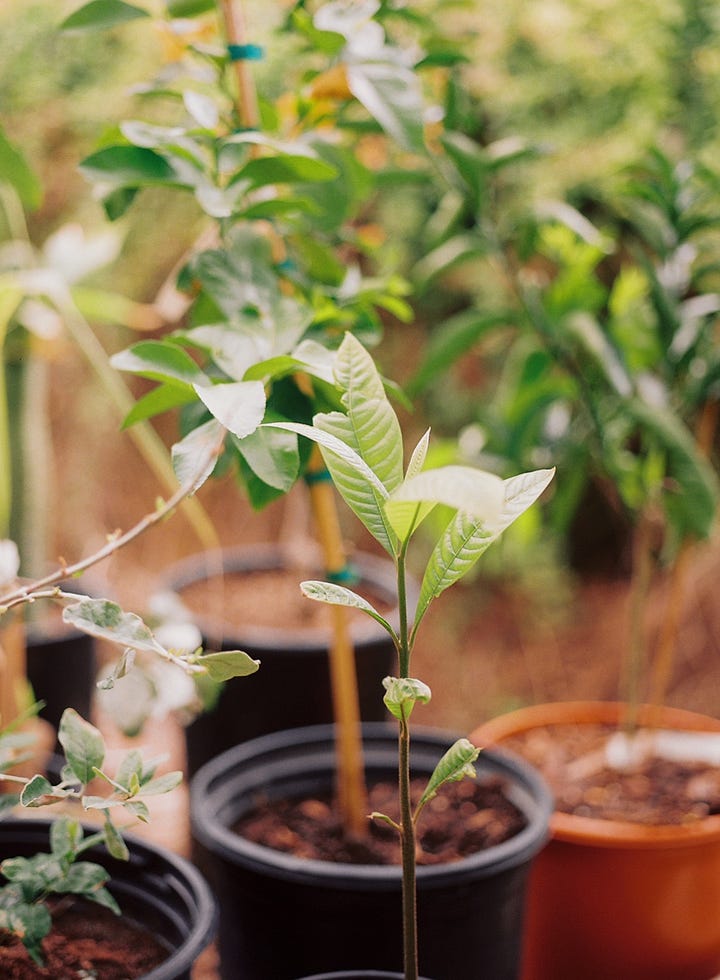
Extensive Horticulture Isn’t New to the Desert
The lands we now know as Arizona and New Mexico have a long, intense history of cultivated desert orchards. According to a historical marker at Sahuaro Ranch in Glendale, Arizona, in 1891, this desert farm even comprised the largest fig and date orchard in the United States; orchards planted with hybrid cultivars of olives, apricots, peaches, almonds, and oranges soon followed there. And they weren’t the only ones.
In 2003, biologists and researchers at the Arizona-Sonora Desert Museum and other Tucson area organizations began the Kino Fruit Trees Project, an effort (literally) to restore barren Spanish Mission Era orchards and gardens by replanting the myriad old-world tree medleys introduced by Father Eusebio Francisco Kino and other Franciscan missionaries in the seventeenth and eighteenth centuries. These orchards and gardens once composed a portion of the mission community’s agricultural economy, which included vineyards, grain fields, vegetable and pharmacy gardens, and livestock. Through extensive research, preservation, and propagation, this ambitious project successfully reintroduced the legacy of fruit tree stocks from Kino’s accounts.
Between its sandy buttes and layered geology, even modern-day Phoenix holds rich, fertile land destined for agricultural distinction. Arizona Worm Farm is nestled into the city’s west side, a family-owned effort that strives to turn the valley’s waste into gardening products, vegetable starts, and produce. Step past the worm piles at the entrance, and you will discover an open demonstration garden showcasing beds of various vegetables as well as orchard groves featuring fig, pecan, pomegranate, sapote, apple, pear, and peach trees, plus lots more.
The desert has always been more than meets the eye.
What Is a Food Forest?
A food forest is precisely what it sounds like: a working ecosystem of edible trees, shrubs, and ground cover. It can be quite small in area, enough to meet the needs of a family, or it can easily be scaled up to a communal scale. Through its tended watering solutions, shade, biodiversity, mulch mixtures, and carbon sequestration, a food forest of any size offers multiple benefits to a community, even beyond critical sustenance and education.
While pomegranates and figs might sound like exotic fruits, they are far from extraterrestrial to the seasoned desert gardener. The arid climate of the American Southwest makes a perfect habitat for seasonal favorites like citrus, nut varieties, mangoes, bananas, eucalyptus, olives, quince, apples, and the like. These trees are the backbone of a food forest.
Once established, an edible permaculture garden is hands-off, meaning less work for you in the long term. With as little as a few weeks of prep work each season, you can acquire a full season’s worth of harvested fruits, vegetables, nuts, and legumes.




It Starts with a Plan
Success in permaculture begins with thoughtful design. Proper planning and strategy are necessary for the yard to be entirely functional. The more intention behind your food forest’s composition, the more abundance it will generate with the least human input.
To achieve the self-sustaining structure and soil environment that support a permacultural garden, it is critical to establish what are known as “layers.” For a fully functioning, self-sustaining food forest, you need seven primary forest layers:
Large shade trees, or “observatory” trees, such as a large pecan or citrus tree.
Understory trees include smaller fruit or nut trees (peach, apple, or plum).
Shrubs, such as berries or currants.
Herbaceous layers, such as perennial greens, mint, and hops.
Root layers, such as carrots or potatoes.
Ground cover.
Vines, such as sweet potato or hops, grapes.
These various layers are meant to reach into the vertical space while covering most of the available horizontal space, leaving no open ground. It may not be possible to incorporate a large observatory tree into a tight outdoor space; in this case, you can easily substitute a dwarf variety.
It is important to choose some nitrogen-fixing trees for either the observatory or understory layer. These particular varieties produce vital nutrients for their surrounding plants, cultivate healthy soil, and maintain strength in their guild during climate extremes by storing nitrogen in small nodules in their root systems. Permaculture experts say these plants boost soil fertility by releasing nitrogen when their roots decompose. Implementing these plants into your design as naturally occurring nitrogen-rich fertilizers will foster years of low-maintenance food production.
Ideal nitrogen fixers for your garden are synonymous with the natural trees that grow like weeds in your area. Black locust, alder, autumn olive, acacia, mesquite, and assorted ash are often seen in desert backyard forests.
Nitrogen fixers are nature’s solution to the current chemical crisis; do away with nasty external artificial preservatives, and your gut (and the climate) will thank you.
HOT TIP: Contrary to popular belief, winter is the ideal time to begin an edible garden. Most trees, shrubs, vines, and herbaceous plants grow hardier when planted in dormancy. (Leafless dormant trees are much cheaper at the nursery, too.)
✨ Cover the Soil
The most significant advantage of transforming your backyard into a lush edible garden is that, once established, you won’t have to water as frequently. Thus, your first task is to replace any water-guzzling yard grass with sturdy, hand-tossed groundcover or mulch. Mulch keeps plant roots cool in the summer and insulates them from freezing in the winter. Once fertilized and decomposed, the mulch ingredients release nutrients into the soil as they decay.
Sheet mulching makes this tiresome task simple: First layer of organic “brown” materials, like cardboard or newspaper, atop the yard’s entire terrain to exclude light. Cover the brown layers with straw, grass clippings, and damp wood chips. The underground materials will break down over time and drastically improve soil quality, creating the perfect outdoor environment for your forest to thrive.
✨ Sheet Mulch Checklist
A source of water and a garden hose
A shovel
Compost or topsoil
Organic materials (such as cardboard, leaves, straw, and grass clippings)
Wood chips
Next, like a pan of lasagna, let the layers bake. Proper breakdown takes time. Expect it to take a few months under the warm sun to decompose properly. Rome wasn’t built in a day, and neither should your yard.
Another option is to plant directly on top of the mulching layer after removing 2 to 3 inches of soil from your plot.
HOT TIP: If you dig the grassy look but don’t want to smother your mulch, try a bountiful cover of strawberry clover. It’s healthier for the soil, requires less water, and looks gorgeous.
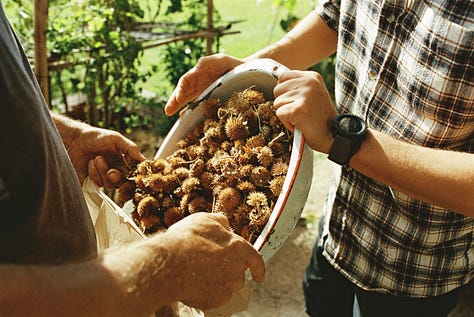


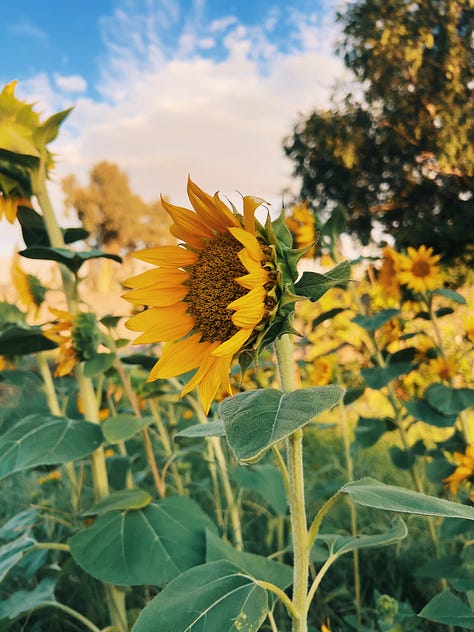
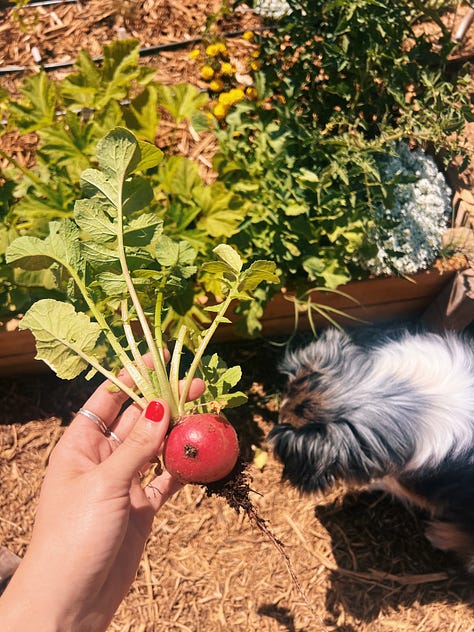

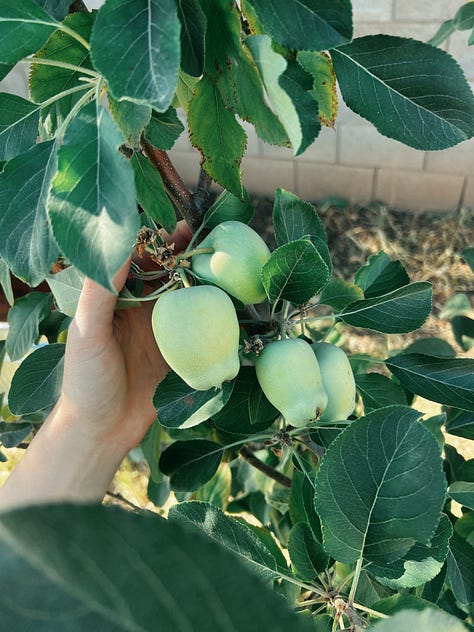


Now, Your Turn
The Southwest is a playground for the green thumb: its everlasting sun and foundational soil system prove sturdy enough for even tropical fruit trees, making it so much easier than you might have imagined to sustain your family’s produce drawer with the aid of only your backyard, a good plan, and a bit of willful back work.
Remember your three guiding stars: intentional design, mulched soil, and nitrogen-fixing plants.
RESOURCES
To learn about the fascinating history of desert orchards in the United States, check out Growing Food in a Hotter, Drier Land: Lessons from Desert Farmers on Adapting to Climate Uncertainty by Gary Paul Nabhan and The Holistic Orchard: Tree Fruits and Berries the Biological Way by Michael Phillips.
For an overview of permacultural principles, including the concept of food forests, I recommend reading Gaia's Garden: A Guide to Home-Scale Permaculture by Toby Hemenway (2009) and Permaculture: A Designers' Manual by Bill Mollison, Reny Mia Slay (1988).
For help designing your food forest, including sample garden plans and lists of species and varieties that would work well in your climate, see How To Design a Food Forest by GroCycle.








